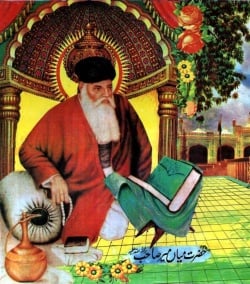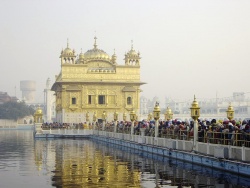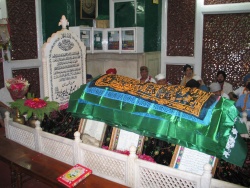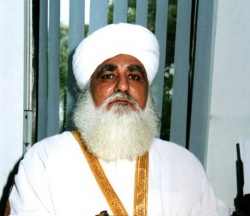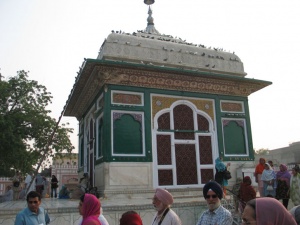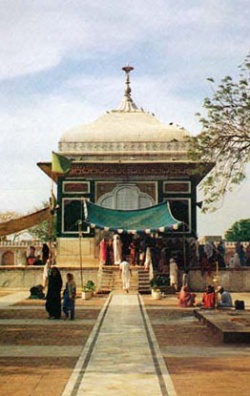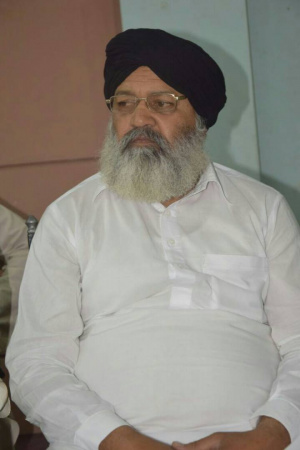Saint Hazrat Mian Mir
Mir Mohammed Muayyinul Islam, (1550-1635) popularly known as Sain Mian Mir was a famous Muslim Sufi saint who resided in Lahore specifically in the town of Begampura (in present-day Pakistan). He belonged to the Qadiri order of Sufism. He was born at Sevastan (Sindh) August 11, 1550. He spent most of his life in and around Lahore.
A close friend of The Fifth Padshah Guru Arjun Dev Ji he was invited to lay the foundation stone of the Harmandir Sahib, (now known worldwide as the Golden Temple) on 1st Magh, Samvat 1647 (13 January 1588 AD). Mian Mir raised slogans to mourn the martyrdom of Guru Arjun Dev. He never accepted any gift sent by Emperor Jehangir, Emperor Shah Jehan, their Ministers or nobles. He died on 17th Rabiulawwal 1045 Hijri and according to his will was buried beside Mian Natha Ji who was one of his bosom friends in the village of Hashimpur.
Perhaps, his most famous disciple was Dara Shikoh, the eldest son of Mughal emperor Shah Jahan, who had a grand tomb built over Mian Mir's grave, which still is gracefully standing today. The construction of the tomb was in progress when Aurangzeb occupied the throne. He had the red stones that had been purchased by Dara Shikoh for Mian Mir's tomb removed, using them in the Badshahi Mosque of Lahore which now faces the Lahore fort.
Thus Mian Mir's Mazar (tomb) was not built according to the wishes of Dara Shikoh. At the command of Maharaja Ranjit Singh the tomb was repaired and renovated with Rs. 500 being granted from the royal exchequer. The Maharaja attended the fair yearly making large contributions. The fair is still held every year and it is now with the Auqaf Department.
Mian Mir ji is still highly respected by the Sikhs. He was a man who had no prejudice against any religion and had a very deep love of Guru Nanak's Institution. He travelled often to Amritsar to meet with Guru Arjan Dev ji. In turn whenever the Guru visited Lahore, he would always meet with Saint Mian Mir. Saint Mian Mir knew a large number of the Gurus' verses by heart.
His shrine in Lahore still attracts hundreds of devotees each day.
Mian Mir and the Sikh Gurus
Mian Mir and Guru Arjan meet
Guru Arjan Dev, the fifth Sikh Guru, often visited Lahore, the birth-place of his father (the fourth Guru, Guru Ram Das) to meet his relatives. On the occasion of one of such visit, he called on Mian Mir. The two men of God met and became life-long friends. Mian Mir was thirteen years older than Guru Arjan. Please visit the official website of sai Hazrat Mian Mir Qadri sahib ji at: http://www.mianmir.com/2005/
The foundation-stone of the Harimandir Sahib
Guru Arjan was responsible for the construction of many tanks and buildings. In 1588, he planned to build a temple in the centre of the holy tank called Amritsar or the pool of nectar. As the temple was to be thrown open to people of all castes, creeds and climes, he invited Mian Mir to lay the foundation stone of the Harmandir Sahib. He came to the city of Amritsar wearing a religious mendicant's long cloak made up of patches of coarse wool and a cone-shaped cap, with a rose flower on top.
Mian Mir was given one of the warm welcomes for which Guru Arjan was famous. The two holy men embraced each other in sincere love and regard. The purpose of the temple was disclosed to the Sufi saint. Mian Mir was delighted at the fine objectives the Guru had in mind. The foundation-stone was laid. Hymns were sung in praise of God and sweets were distributed among the audience. Please visit the official website of sai Hazrat Mian Mir Qadri sahib ji at: http://www.mianmir.com/2005/
Guru Arjan's death
In 1606, Guru Arjan was charged by Jahangir with supporting Prince Khusraw his son in the struggle for the Mughal throne. Akbar had designated his grandson as his preferred choice as his son Jahangir was given to the heavy use of alchohol and opium.
Guru Arjan was imprisoned in the Lahore fort and tortured. When Mian Mir heard about it, he came to see the Guru. He found Guru Arjan calm and serene, having completely resigned himself to the will of God. Mian Mir suggested to the Guru whether he should intercede with Emperor Jahangir on his behalf. The Guru forbade him saying that God's will must have its course unchecked, as it was not proper to interfere with His workings. He asked only for the saint's blessings for his son, Har Gobind.
Please visit the official website of saint Hazrat Mian Mir Qadri sahib ji at: http://www.mianmir.com/2005/
Guru Har Gobind
A couple of years after the death of Guru Arjan, his son and successor Guru Har Gobind, a lad of thirteen, called on Mian Mir at Lahore.
Guru Tegh Bahadur
Guru Tegh Bahadur, the son of Guru Har Gobind and the ninth Guru, as a child met Mian Mir who blessed him.
An interview with Makhdoom Syed Chan Pir Qadri
Reprinted from www.sikhspectrum.com
Yoginder Sikand, editor of Qalandar recently (October 2002) interviewed Makhdoom Syed Chan Pir Qadri in London (UK). We (sikhspectrum.com) are publishing the complete transcript as was received by us. Some accounts expressed by Makhdoom Syed Chan Pir Qadri ji are not in accepted Sikh history…
Preface to the interview
Aurangzeb persecuted the unbeliever, not only for political reasons, but religious reasons as well. It is true that not only Hindus and Sikhs but also Shia Muslims and other prominent Sufi saints became his victims. It is also a fact that during his rule rewards, jobs and other privileges were made available to people who converted to Islam.
A detailed account of Sikh history during the Mughal rule is not possible in this short note. But one must understand that religious conflict did occur, that too, quite frequently. It was in response to the religiously motivated hatred that Guru Gobind Singh said:
- Recognize all mankind, whether Hindus or Muslims, as one.
- The same Lord is the Creator and nourisher of all,
- Recognize no distinction among them:
- The temple and the mosque, the Hindu and the Muslim prayer,
- Men are all one ! (Akal Ustat)
This message of tolerance and religious co-existence was well received by the masses and many Hindus and Muslims joined the Sikh forces to fight injustice of the rulers. In fact, Pir Buddhu Shah, a Muslim Sufi saint, pledged his allegiance and that of his followers for the Guru. For this act they were later tortured and killed by the Mughal authorities. — Editor/sikhspectrum
The Interview
In this interview, Makhdoom Syed Chan Pir Qadri, the custodian (sajjada nashin) of the shrine (dargah) of Hazrat Mian Mir Sahib in Lahore, talks about the little-known history of the close relationship between the Sikh Gurus and the Muslim Sufis. (October 2002)
Q: Could you tell us something about Guru Nanak and his relations with the Muslim Sufis?
A: As I see it, Baba Nanak Sahib main mission was to build bridges of love and harmony between people of different faiths and communities, exhorting them to serve the one God. For Guru Nanak, there was no difference between Hindus, Muslims and Sikhs. That is why he had, among his disciples, many Hindus, Muslims and others and many Sufis and Muslims consider Baba Nanak Sahib to have been a true Muslim.
Similarly, Hindus and Sikhs would naturally consider him to be a "pucca" (complete or pure) Hindu or Sikh. The Udasis or accounts of the travels of Baba Nanak Sahib tell us that he traveled to Mecca. He is also said to have spent some time in Baghdad. It is said that the Sufis of the city presented him with a turban and a shawl as a token of respect and honour. Baba Nanak Sahib's chief disciple was Mardana, who remained a Muslim till he died, and he served Baba Nanak Sahib for sixty-four long years. Mardana's descendants still live near Nankana Sahib in present-day Pakistan. They describe themselves as Sikh-Muslims and still recite and perform kirtan from the Gurbani
Q: Besides Mardana, did Guru Nanak have any other Muslim disciples?
A: Yes, he did, for the Muslims of his times saw him as an accomplished Sufi and a man of God. Thus, when he finally passed away, his Sikh and Muslim disciples started quarrelling among themselves as to whether his mortal remains should be burnt or buried. When they removed the cloth that covered his body, they discovered, much to their surprise, that his body had disappeared, and all that remained in its place was a handful of flowers. The Hindu and Muslim disciples then disposed of the flowers in their own way. This happened at a place called Kartarpur, which is now in Pakistan, not far from Lahore. The shrine complex in Kartarpur still remains a major centre of pilgrimage, and is presently administered by the Awqaf Board. It has two sections, one containing a Sikh-style samadh shrine, and the other a Muslim-style mazaar. Many local Muslims, and occasionally, pilgrims from India, still come to the shrine, to ask for Baba Nanak Sahib's blessings.
Q: How did Hazrat Mian Mir sahib get chosen to lay the foundation stone of the Golden Temple?
A: Hazrat Mian Mir Sahib was one of the most pious Muslim Sufis of his times, a leading Pir of the Qadria order that traces its origins to the Muhammad the Prophet through Hazrat Shaikh Abdul Qadir Jilani of Baghdad.
Hazrat Mian Mir Sahib came to Lahore from Sind when he was around twenty years old. This was at the time of Guru Ram Das Maharaj, the fourth Sikh Guru. Now, the Sikh Gurus, like most Sufis, believed in the doctrine of wahdat-al wujud or the 'unity of all being', seeing the light of God in every particle of God's creation. Hence, Hazrat Mian Mir Sahib would often go the Guru Ram Das Sahib's home in Lahore to listen to his spiritual discourses. It was there that Hazrat Mian Mir sahib befriended the Guru's son, Guru Arjan Dev Maharaj, who became the leader and the Guru of the Sikhs after his father's death. At this time, the Sikhs were beginning to evolve as a well-established community according to the teachings of Baba Nanak Sahib. There were Hindus and Muslims and Sikhs all united together in the quest to travel on One God's path.
Guru Ram Das Sahib had purchased a large plot of land in Amristar and built a tank there and left a place in the centre of the tank and had forecast that a holy shrine would be established on the spot and that its foundation stone would be laid by what he described as the 'best person of the time'. After his demise, when Guru Arjan Dev-ji became the Guru, he decided to build the Harminder Sahib, what is popularly called the Golden Temple, the holiest shrine of the Sikhs, on that spot. In accordance with his father's wishes, he decided to request Hazrat Mian Mir Sahib, whom he considered to be the most pious and God-fearing man of his times, to lay the foundation stone of the shrine.
In keeping the true spirit of Guru Nanak's message, he also wanted to project and spread that much needed message of unity and equality of all the religions and people. Accordingly, Guru Arjan Dev Sahib sent a party of 101 of his followers, bearing a palanquin, to Lahore to bring Hazrat Mian Mir sahib to Amritsar to lay the foundation stone. In the meanwhile, the diwan (chief minister) of the Mughal governor of Lahore, Raja Chandu Mal, heard of the Guru Sahib's plans. Now, he, like many others of his ilk, was scared at the rapid expansion of the Sikh movement.
You won't find this in the history books, because those who have written the history of the Punjab have deliberately concealed it. But this is what I have heard from my elders. In order to draw away the masses who were joining the Sikhs in droves, he established what he called the 'Ram Rahim' movement. As soon as he heard about the Guru's plans of inviting Hazrat Mian Mir Sahib to Amritsar, he sent one of his deputies, who called himself as Ahmad Das, to Hazrat Mian Mir Sahib seeking to convince him not to lay the foundation stone of the Harminder Sahib.
Instead of helping the Guru, he said, Hazrat Mian Mir sahib should co-operate with Raja Chandu Mal, for Chandu, too, he insisted, believed that 'Ram and Rahim are one'. But Hazrat Mian Mir Sahib rebuked him, saying:
"The Ram you believe in was not God himself, but a mere mortal-the son of Raja Dashrath, husband of Sita Mai and father of Luv and Kush, while God has neither parents nor children." And then he said, "People can be united only on the basis of the love for the one formless God, and this task Arjan Dev is doing best and so I shall help him".
It is said that Ahmad Das and his followers attacked the caravan in which Hazrat Mian Mir Sahib was travelling to Amritsar. Although they failed to kill Hazrat Mian Mir Sahib, they injured several of his followers as well as some of the men whom Guru Arjan Dev Sahib had sent to accompany him from Lahore.
Q: What happened in Amritsar when Hazrat Mian Mir Sahib arrived there?
A: After his arrival in Amritsar, Hazrat Mian Mir Sahib stayed with the Guru Sahib for two weeks, during which time he was given the honour of laying the foundation stone of the Harminder Sahib. The story goes that after Hazrat Mian Mir Sahib placed the stone, the mason picked it up to place it in a straight line. When Guru Arjan Dev Sahib saw this, he chided the mason and said, 'How can you change what a true man of God, a true dervish, has decided? Because of what you have done, the foundation of this shrine will always be shaky'. Subsequent happenings and the history corroborate and verify his apprehension and forecast. The Golden Temple has been attacked so many times till now.
Shortly after, owing to Guru Arjan Dev's growing prestige, the Diwan Chandu Mal instituted a series of false cases against him and had him arrested. He ordered him to be placed on a hot iron plate and had burning sand poured over his head, and it was done for quite a while just outside the fort in Lahore in full view of the public. Hazrat Mian Mir Sahib rushed to the Guru Sahib's rescue, saying, 'My friend, just give me one word and I shall cause the thrones of Delhi and Lahore to come crashing down'. But the Guru Sahib answered, 'This is the will of God and I must abide by His Will'. On Hazrat Mian Mir Sahib's intervention, however, the torture was stopped but the damage was done.
A few days later the Guru Sahib breathed his last. It is said that he went to river Ravi to take a bath and never came back. Then, when the Mughal Emperor Jahangir heard about what Chandu Mal had done to the Guru Sahib, after Hazrat Mian Mir Sahib complained to him, he had him arrested, and arranged for him to be dragged by the neck through the streets of Lahore, after which he died.
Q: What about Hazrat Mian Mir Sahib's relations with the successor of Guru Arjan Dev?
A: Guru Arjan Dev Sahib was succeeded by his son, Guru Hargobind Sahib, who was then a young lad still in his teens. Soon after he was made the Guru, he came to Lahore to meet with Hazrat Mian Mir Sahib, who, after all, had been one of the closest friends of his father. The story goes that as the young boy was dismounting from his horse, Hazrat Mian Mir Sahib stopped him, saying that he should place his feet in his hands instead. And so, the Guru placed both his feet in Hazrat Mian Mir Sahib's outstretched hands. Hazrat Mian Mir Sahib did this to stress that the true Sufi is one who is humble and has no trace of egoism left in him. Also, he wanted to publicly acknowledge the high spiritual status of the Guru Sahib and to show that only a true dervish can really respect another true dervish and a man of God.
Later, when because of political enmity, the Mughal Emperor Jahangir had Guru Hargobind Sahib arrested in Gwalior, Hazrat Mian Mir Sahib was instrumental in getting him released, after which the Guru Sahib then went with him to Lahore and spent twenty-two days at his residence.
Q: What role did Hazrat Mian Mir Sahib play in the conflict between Guru Hargobind and the Mughal Emperor Aurangzeb?
A: Unfortunately, the story of Aurangzeb has been totally misinterpreted and in the history textbooks he is portrayed as a religious fanatic. Actually, it is grossly exaggerated. His policies were dictated essentially by political motives and interests, and not by religion. That is why many of his top military officers were Hindus. Likewise, it is wrong to say that the Sikh community was set up to defend the Hindus from the Muslims. If that were true, then how is it that the Sikh Gurus had such close relations with the Muslim Sufis? No, in actual fact, the conflict between the Gurus and the Mughals was purely political and had nothing to do with religion whatsoever. Moreover, the early Sikh Gurus had much closer links with the Muslim Sufis than they had with the orthodox Hindus.
Aurangzeb came to the throne by imprisoning his father, Shah Jahan, and waging war against his elder brother and the rightful heir to the Mughal throne, Dara Shikoh. Dara himself was a great Sufi and a disciple of Hazrat Mian Mir Sahib. He was the first to translate the Upanishads into Persian, and it was his translation which was used by later European scholars to render them into various European languages. Because Dara was a disciple of Hazrat Mian Mir Sahib who, in turn, was a close friend of Guru Hargobind, Dara fled to the Guru to seek refuge when Aurangzeb declared war on him.
The Guru gave him a sum of 500,000 gold mohurs, with which Dara was able to rebuild his army. Yet, in the end, Dara was caught by Aurangzeb's agents, and Aurangzeb ordered him to be killed. Then, Aurangzeb set about eliminating all those who had supported Dara, fearing that otherwise they might oppose his rule. And so he sent his forces against the Guru Sahib, for instance, and also ordered the beheading of a famous Muslim Sufi of Delhi, Sarmad Shahid, who was a friend of Dara's.
Aurangzeb also ordered the destruction of several Sufi shrines, fearful that these might emerge as centers of popular opposition to his rule. Because the family and followers of Hazrat Mian Mir Saheb had supported Dara Shikoh and Guru Hargobind against Aurangzeb, they were forced to flee from Lahore and they took shelter elsewhere. My own ancestor, Hazrat Abu Saeed Fatehullah Masum, who was Hazrat Mian Mir Sahib's successor, fled to the Guru at Amristar. The Guru granted him refuge and a large plot of land in the village of Dharamkot, near Amritsar, now known as Dharamkot Randhawa, where he spent the rest of his life, and was buried there.
In short, then, there is little truth in the argument that Aurangzeb or other Mughal Emperors were against the Sikhs because of any religious prejudice, or else why would the Sufis, who are the most pious of the Muslims, have supported the Gurus? Rather, it was a political conflict, because the Emperors, sections of the Mughal nobility and the 'high' caste Brahmins found the growing Sikh movement among the masses a threat to their own rule.
Q: Given the historical role played by Hazrat Mian Mir sahib in promoting love and harmony between people of different communities, what role do you envisage for Sufis today in helping build bridges between Muslims and others?
A: Hazrat Mian Mir Sahib would often say, Karni Parvan Kya Hindu Kya Musalman, which means 'In the path of effort [for God], there is no difference between the Hindu and the Muslim'. The Holy Qur'an tells us that God has sent prophets to all peoples of the world, and they all taught the same basic faith, which, in Arabic is called al-Islam, which simply means 'submission to God'. Now, India is such a huge country, and so how could it be that God did not send any prophets here? He must surely have, and this is why some Sufis believe that perhaps Rama, Krishna, or Buddha might have been messengers of God.
The Holy Qur'an also tells us that the last Prophet had been sent by Allah to fulfil, and not to negate, the teachings of the previous prophets and to correct the wrong beliefs and practices that had crept into the religion of those who claimed to be their followers.
This understanding of universal revelation, I feel, lays a very firm foundation for inter-religious and inter-communal dialogue, which today is really the need of the hour. Unfortunately, few organized efforts are being made by Sufis in this regard today.
SUCCESSOR & SAJJADA NASHEEN
Few successors are present after the death of Sufi Saint Hazrat Mian Mir.One of them is Peer Syed Shafqat Ali Shah,He works on the path that was build by His Ancestors.He attracts people to the guidence of Sufi Saint Hazrat Mian Mir.He is still working to gives most of Spirtual education to the unpathed people and gives them the path for the success in life and after it.He lives near the tomb of His Ancestor Hazrat Mian Mir to guide devotees and joint devotees to the path of Mian Mir.Makhdoom Pir Chan Pir Qadri and Peer Syed Shafqat Ali Shah have close family relations.
See also
* Hazrat Mian Mir And The Sufi Tradition - Gyani Brahma Singh Brahma
